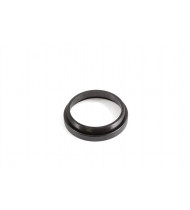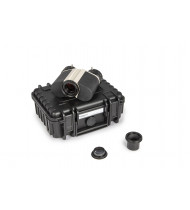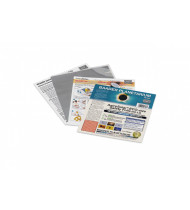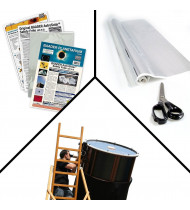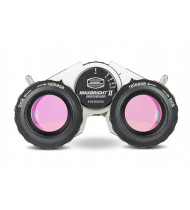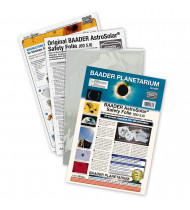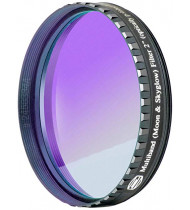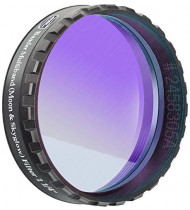Search results for 'wishlist index add product 41461 form_key Hplnh07FBIo7vcDI'
- To connect DSLR T-rings
- Connection to the Astro T-2 system for classical eyepiece projection
- For Hyperion and Morpheus® eyepieces
- For a larger scale projection can be additionally T-2 extension tubes (M42 x 0.75, available in lengths of 7.5 / 15/40 and 8-14 mm variable) Screw
OUT OF STOCK
- Baader MaxBright® II Binoviewer with adapters to T-2 and Zeiss micro-bayonet in a padded carrying case
- 27mm prisms with 26 / 25,5mm clear aperture, for all 1,25"-eyepieces – up to focal lengths of 35mm
- Ergonomically designed ClickLock® eyepiece clamps with diopter adjustment
- Baader Astro T-2 System™ connector thread (M 42 x 0.75) and Zeiss micro-bayonet for the shortest possible connection to (almost) all existing telescope systems
- Optical tube length: 110 mm (+/- 1 mm tolerance)
- with special accessories:
- Glasspathcorrector 1:1,70 for Baader-Binoviewer with T-2 thread (MaxBright II® and MaxBright®) (#2456316, € 96,-)
- Baader Nose piece 1¼" / T-2 (T-2 part #14) (#2458105, € 24,-)
- AstroSolar® ECO-size Safety Film 5.0 for solar observation and photography at high magnification
- Size: ca. 140 x 155 mm, incl. DIY-instructions and DIY cutting-template – telescope quality – Optical Density (OD) = 5.0
- Safe for visual solar observation (with additional optics) and imaging
- This highest precision film consistently produces strehl ratios of 94 to 96 percent at interferometric tests – thus it performs optically like a Fluorite Triplet Lens by Carl Zeiss or Astro Physics
- For more than 25 years on the market, the only film-material made to not deteriorate the optical wavefront, it does allow to attain high magnification with any long-range optics without reducing sharpness or contrast of the solar surface.
- The film is from the same material as our proven AstroSolar® Safety Filme 5.0 in A4-size, due to high demand now availble in a smaller size at an economical price, suitable as solar filter for small telescopes, finders, binoculars, spotting scopes and camera lenses
OUT OF STOCK
- AstroSolar® Safety Film 5.0 for solar observation and photography at high magnification, telescope quality, Optical Density (OD) = 5.0
- Safe for visual solar observation (with additional optics) and imaging
- This highest precision film consistently produces strehl ratios of 94 to 96 percent at interferometric tests – thus it performs optically like a Fluorite Triplet Lens by Carl Zeiss or Astro Physics
- AstroSolar Safety Film is best suited for precision work with all astronomical telescopes and binoculars – just as well as for all photographic camera- and tele-lenses
- For more than 25 years on the market, the only film-material made to not deteriorate the optical wavefront, it does allow to attain high magnification with any long-range optics without reducing sharpness or contrast of the solar surface.
OUT OF STOCK
Baader MaxBright II Binoviewer with case
US$ 387.31Finally Baader introduces the MaxBright® II Binoviewer. It closes the gap between cheaper entry-level binoviewers and our high-end Mark V Giant Bino.
- 27mm prisms with 26 / 25,5mm clear aperture, for all 1,25"-eyepieces – up to focal lengths of 35mm
- Ergonomically designed ClickLock® eyepiece clamps with diopter adjustment
- Baader Astro T-2 System™ connector thread (M 42 x 0.75) and Zeiss micro-bayonet for the shortest possible connection to (almost) all existing telescope systems
- Scope of delivery: Baader MaxBright® II Binoviewer with adapters to T-2 and Zeiss micro-bayonet in a padded carrying case (image coming soon)
- Optical tube length: 110 mm (+/- 1 mm tolerance)
- Weight: 595g (200g lighter than Mark V)
OUT OF STOCK
- AstroSolar® Safety Film 5.0 for solar observation and photography at high magnification, telescope quality, Optical Density (OD) = 5.0
- Safe for visual solar observation (with additional optics) and imaging
- This highest precision film consistently produces strehl ratios of 94 to 96 percent at interferometric tests – thus it performs optically like a Fluorite Triplet Lens by Carl Zeiss or Astro Physics
- AstroSolar Safety Film is best suited for precision work with all astronomical telescopes and binoculars – just as well as for all photographic camera- and tele-lenses
- For more than 25 years on the market, the only film-material made to not deteriorate the optical wavefront, it does allow to attain high magnification with any long-range optics without reducing sharpness or contrast of the solar surface.
OUT OF STOCK
Baader Neodymium 2" (Moon & Skyglow)-Filter
US$ 127.93- The best visual and photographic filter for contrast enhancement for all telescopes, without loss of image brightness!
- The effect of the element neodymium as filter material is very impressive. When added to optical glass, it enhances contrast, enhances the red colour in the image (especially with Mars and Jupiter) and it darkens the spectral region which is particularly marked by street lamp light, which is the biggest contributor to the nightly "Skyglow".
- Planoptically polished and MC-coated – with IR-cut coatings!, without any loss of sharpness as a single filter in front of a binocular or be used for afocal projection with digital cameras (far from the focal point!)
- The IR spectral range is blocked making stars much sharper when used with dSLRs.
- The best visual and photographic filter for contrast enhancement for all telescopes, without loss of image brightness!
- The effect of the element neodymium as filter material is very impressive. When added to optical glass, it enhances contrast, enhances the red colour in the image (especially with Mars and Jupiter) and it darkens the spectral region which is particularly marked by street lamp light, which is the biggest contributor to the nightly "Skyglow".
- Planoptically polished and MC-coated – with IR-cut coatings!, without any loss of sharpness as a single filter in front of a binocular or be used for afocal projection with digital cameras (far from the focal point!)
- The IR spectral range is blocked making stars much sharper when used with dSLRs.


